check engine CADILLAC DEVILLE 1995 7.G User Guide
[x] Cancel search | Manufacturer: CADILLAC, Model Year: 1995, Model line: DEVILLE, Model: CADILLAC DEVILLE 1995 7.GPages: 403, PDF Size: 20.69 MB
Page 164 of 403
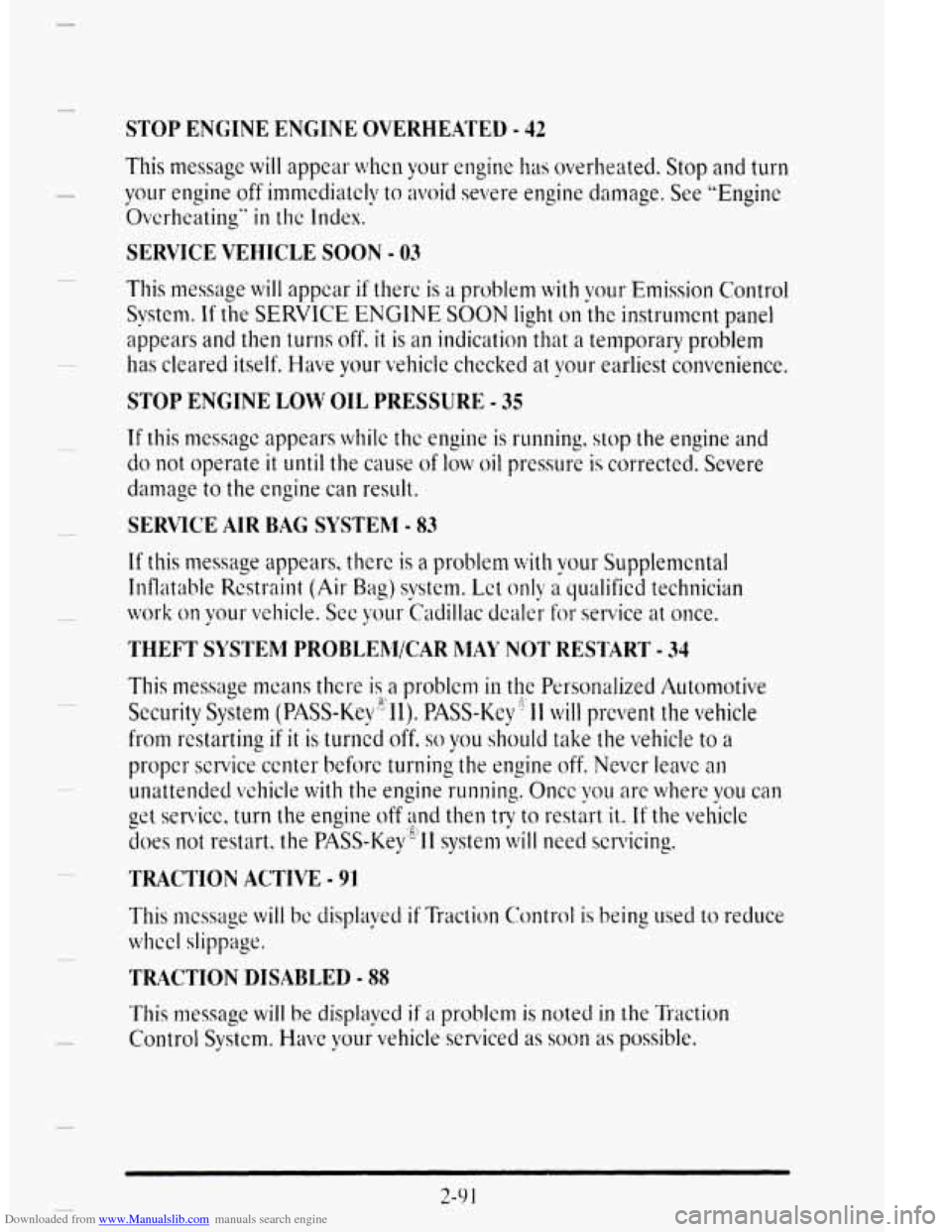
Downloaded from www.Manualslib.com manuals search engine STOP ENGINE ENGINE OVERHE'4TED - 42
This message will appear whcn your engine has overheated. Stop and turn
your engine off imrnediatcly to ;woid severe engine damage. See "Engine
Ovcrhcating" in thc Index.
SERVICE VEHICLE SOON - 03
This message will appcar if therc is a problem with vour Emission Control
Svstem.
If tho SERVICE ENGINE SOON light on& instrument panel
appears
and then turns off, it is an indication that a temporarv problem
has cleared itself. Have your vehicle checked at your earliest convenience.
STOP ENGINE LOW OIL PRESSURE - 35
If this messagc appears whilc thc engine is running. stop the engine and
do not operate it until the cause of low oil pressure is corrected. Severe
damage
to the engine can result.
SERVICE AIR BAG SYSTEM - 83
If this message appears, therc is a problem with vour Supplemental
Inflatable Restraint (Air Rag) svstern. Lct only aqualificd technician
work
on your vst~ic~e. ~ec your tadillac dca~er for service at once.
THEFT SYSTEM PROBLEkl/CAR MAY NOT RESTART - 34
This message means there is a problem in the Personalized Automotive
Security
System (PASS-Key"'I1). PASS-Key '' I1 will prevent the vehicle
from restarting L if it is turnid off, so you should take the vehicle to a
propcr service center beforc turning the engine off. Never leave (117
unattended vchicle with the engine running. Oncc vou are wherc you can
L get ssrvicc, turn the engine off and then try to restart it. If the ve1;icle
does not restart, the PASS-Key:% system will need scnricing.
TRACTION ACTIVE - 91
This nlcssage will bc displayed if Traction Control is being used to reduce
whcel slippage.
TRACTION DISABLED - 88
This message will be displayed if 21 problcm is noted in the Traction
Control System.
Haw your vehicle serviced as soon as possible.
2-9 1
Page 168 of 403
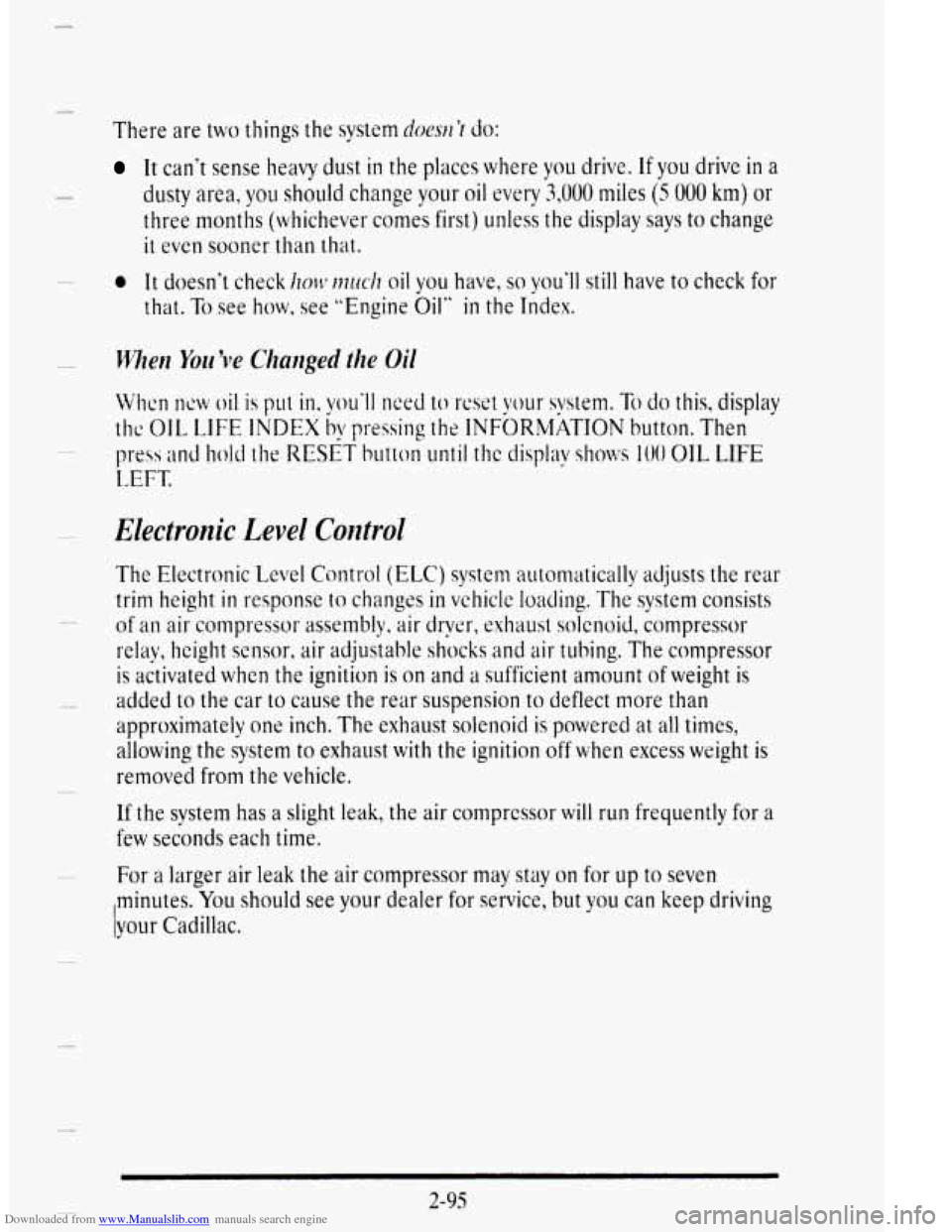
Downloaded from www.Manualslib.com manuals search engine c
There are two things the system docsrl’r do:
It can’t sense heavy dust in the places where you drive. If you drive in a
dusty area, you should change your oil every 3,000 miles (5 000 km) or
three months (whichever comes first) unlesi the display says to change
it eve11 somer than that.
0 It doesn’t check IIOCV much oil you have, so you‘ll still have to check for
that. To see how, see “Engine Oil“ in the Index.
Electronic Level Control
The Electronic Level Control (ELC) system autonmtically adjusts the rear
trim height in response to changes in vehicle loading. The system consists
of
an air compressor assembly, air drver, exhaust solcnoici, compressor
relay, height sensor, air adjustable shocks and air tubing. The compressor
is activated
when the ignition is on and a sufficient amount of weight is
added
to the car to cause the rear suspension to deflect more than
approximately one inch. The exhaust solenoid
is powered at all times,
allowing the system to exhaust with the ignition off when excess weight
is
removed from the vehicle.
If the system has a slight leak, the air compressor will run frequently for a
few seconds each time.
For a larger air leak the air compressor may stay on for up to seven
minutes. You should see your dealer for service, but
you can keep driving
lyour Cadillac.
2-95
Page 173 of 403
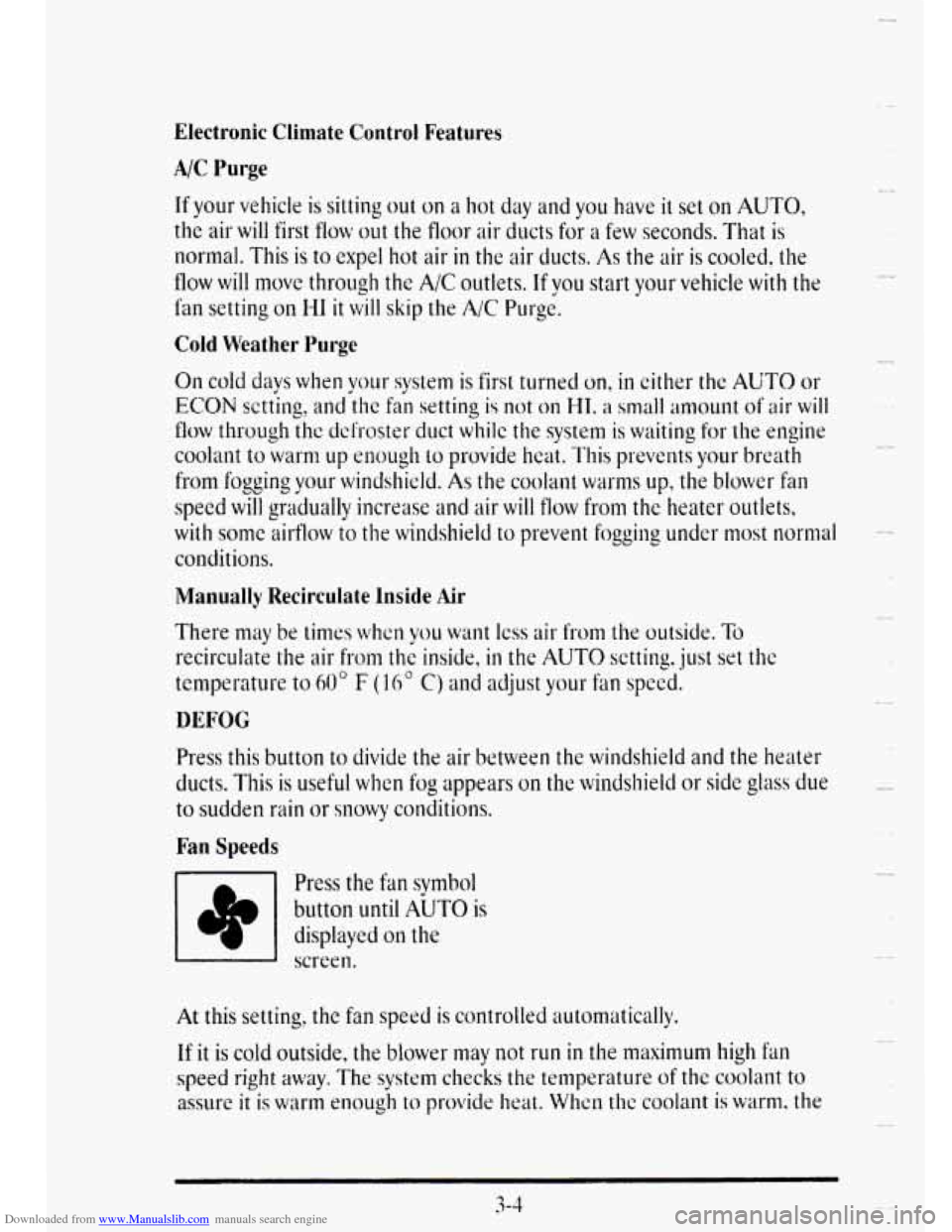
Downloaded from www.Manualslib.com manuals search engine Electronic Climate Control Features
A/C Purge
If your vehicle is sitting out on a hot day and you have it set on AUTO,
the air will first flow out the floor air ducts for a few seconds. That is
normal. This is to
expel hot air in the air ducts. As the air is cooled. the
flow will move through the A/C outlets. If you start your vehicle with the
fan setting on HI it will skip the A/C Purge.
Cold Weather Purge
On cold days when your system is first turned on, in either the AUTO or
ECON setting? and the fan setting is not on HI, a small amount of air will
flow through thc defroster duct whilc the system is waiting for the engine
coolant
to warm up enough to provide hcat. This prevents your breath
from fogging your windshield. As the coolant warm up, the blower fan
specd
will gradually increase and air will flow from the heater outlets,
with some airflow to the windshield to prevent fogging under most normal
conditions.
Manually Recirculate Inside Air
u
There may be times whcn vou want less air from the outside. To
recirculate the air from thi inside, in the AUTO setting, just set the
temperature to 60” F (16* C) and adjust your fan speed:
DEFOG
Press this button to divide the air between the windshield and the heater
ducts.
This is useful when fog appears on the windshield or side glass due
to sudden rain or snowy conditions.
Fan Speeds
/+
Press the fan symbol
button until AUTO is
displayed on the
screen.
At this setting, the fan speed is controlled automatically.
If it is cold outside, the blower may not run in the maximum high fan
speed right away. The system checks the temperature of the coolant to
assure it is warm enough to provide heat. When thc coolant is warnl, the
Page 191 of 403
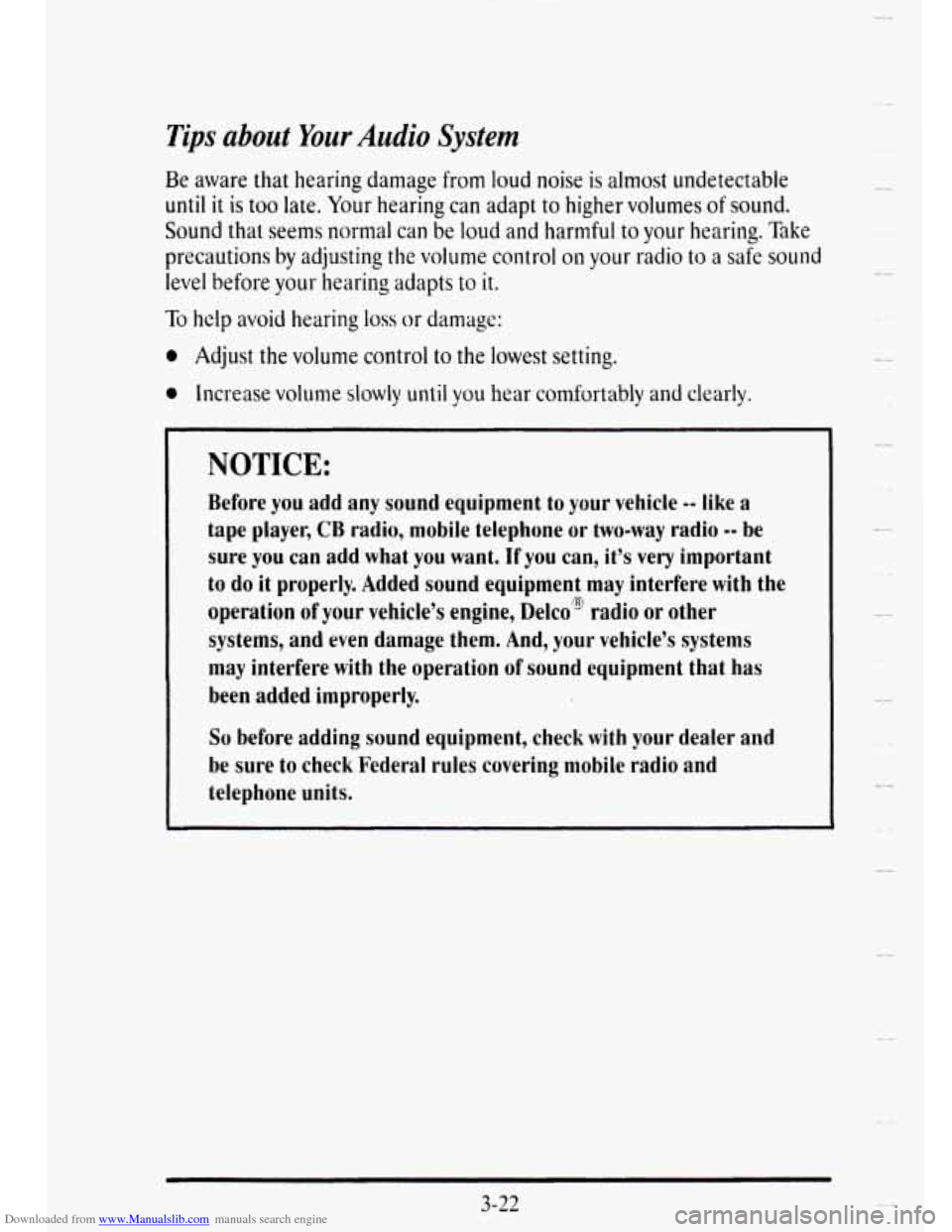
Downloaded from www.Manualslib.com manuals search engine Tips about Your Audio System
Be aware that hearing damage from loud noise is almost undetectable
until it is too late. Your hearing can adapt to higher volumes of sound.
Sound that
seems normal can be loud and harmful to your hearing. Take
precautions by adjusting the volume control on your radio to a safe sound
level before
your hearing adapts to it.
To hclp avoid hearing loss or damage:
0 Adjust the volume control to the lowest setting.
0 Increase volume slowly until you hear comfortably and clearly.
~~ ~~~~~~~~~
NOTICE:
Before you add any sound equipment to your vehicle -- like a
tape player, CB radio, mobile telephone or two-way radio
-- be
sure you can add what you want.
If you can, it's very important
to do it properly. Added sound equipment may interfere with the
operation
of your vehicle's engine, Delco" radio or other
systems, and even damage them. And, your vehicle's systems
may interfere with the operation of sound equipment that has
~ been added improperly.
So before adding sound equipment, check with your dealer and
be sure to check Federal rules covering mobile radio
and
telephone units.
3-22
u
Page 207 of 403

Downloaded from www.Manualslib.com manuals search engine So here are some tips for passing:
0
0
e
e
0
e
0
"Drive ahead." Look down the road, to the sides, and to crossroads for
situations that might affect your passing patterns. If you have any
doubt whatsoever about
making a successful pass, wait for a better
time.
Watch for traffic signs, pavement markings, and lines.
if yo^ can see a
sign up ahead that might indicate a turn or an intersection, delay your
pass.
A broken center line usually indicates it's all right to pass
(providing the road ahead is clear). Never cross a solid line on your
side
of the lane or a double solid line, even if the road seems empty of
approaching traffic.
Do not get too close to the vehicle you want to pass while you're
awaiting an opportunity. For one thing, following too closely reduces
your area
of vision, especiallv if you're following a larger vehicle. Also,
you won't have adequate space if the vehicle ahead suddenly slows or
stops. Keep back
a reasonable distance.
When
it looks like a chance to pass is coming up, start to accelerate
but stay
in the right lane and don't get too close. Time your move so
you will be increasing specd as the time comes to move into the other
lane.
If the way is clear to pass, you will have a "running start" that
more than makes up
for the distance you would lose by dropping back.
And
if something happens to cause you to cancel your pass. you need
only
slow down and drop back again and wait for another opportunity
If other cars are lined up
to pass a slow vehicle, wait your turn. But
take care that someone
isn't trying c to pass you as you pull out to pass
the slow vehicle. Remember to glance over your shoulder ;ind check
the blind spot.
Check your mirrors. glancc
OVC~ your shoulder. ;~nd start your lcft 1;tnc
change signal bcfortj moving out of thc right 12111~ to pass. Whcn you
are far enough ahead of the passul vehicle to see its front in your
inside mirror, activate your right lane change signal and move back
into the right lane. (Remember that your right outside mirror is
convex. The vehicle
you just passed may seem to be farther away from
you than it really is.)
Try not to pass more than one vehicle at a time on two-lane roads.
Reconsider before passing
the next vehicle.
4-1 4
Page 210 of 403
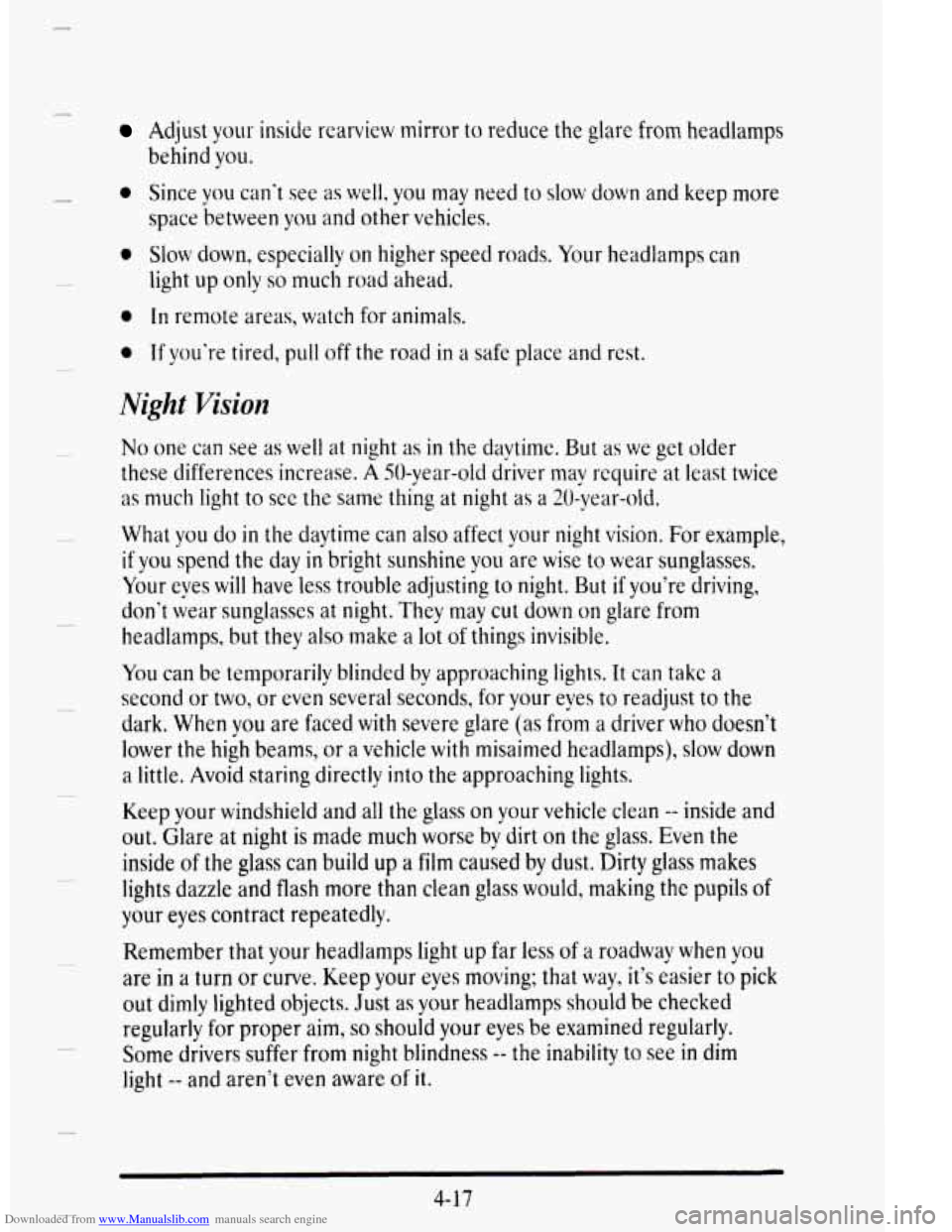
Downloaded from www.Manualslib.com manuals search engine 0
0 0
0
Adjust your inside rearview mirror to reduce the glare from headlamps
behind you.
Since you can‘t see
as well, you may need to slow down and keep more
space between
you and other vehicles.
Slow down, especially on higher speed roads. Your headlamps can
light up only
so much road ahead.
In remote areas, watch for animals.
If you’re tired, pull off the road in a safe place and rest.
Night Vision
No one can see as well at night as in the daytime. But as we get older
these differences increase. A 50-year-old driver may require at least twice
as much light to see the same thing at night as a 20-year-old.
What
you do in the daytime can also affect your night vision. For example,
if you spend the day in bright sunshine you are wise to wear sunglasses.
Your eyes
will have less trouble adjusting to night. But if you’re driving,
don’t wear sunglasses at night. They may cut down on glare from
headlamps, but they also make a lot of things invisible.
You can be temporarily blinded
bv approaching lights. It can take a
second or two, or even several seconds, for your eves to readjust to the
dark. When
YOU are faced with severe glare (as frim a driver who doesn’t
lower the
high beams, or a vehicle with misaimed headlamps), slow down
a little. Avoid staring directly into the approaching lights.
Keep
your windshield and all the glass on your vehicle clean -- inside and
out. Glare at night is made much worse
by dirt on the glass. Even the
inside
of the glass can build up a film caused by dust. Dirty glass makes
lights dazzle and flash more than clean glass would, making the pupils of
your eyes contract repeatedly.
Remember that your headlamps light up far
less of a roadway when you
are in a turn or curve. Keep your eyes moving; that way, it’s easier to pick
out dimly lighted objects. Just as
your headlamps should be checked
regularly for proper aim,
so should your eyes be examined regularly.
Some drivers suffer
from night blindness -- the inability to see in dim
light
-- and aren’t even aware of it.
4- 3.7
Page 214 of 403

Downloaded from www.Manualslib.com manuals search engine CITYDRIVING
P
r I
P I
r
One of the biggest problems with city streets is the amount of traffic on
them. You’ll want to watch out for what the other drivers are doing and
pay attention to traffic signals.
Here are ways to increase your safety
in city driving:
0
F
i
a
a
Know the best way to get to where you are going. Gct a city map and
pian your trip into an unknown part
of the city just as you would for a
cross-country trip.
Try to use the freeways that rim and crisscross most large cities. You’ll
save time and energy. (See the next part, “Freeway Driving.”)
Treat
a green light as a warning signal. A traffic light is there because
the corner
is busy enough to need it. When a light turns green, and just
before you start to move, check both ways for vehicles that have
not
cleared the intersection or may be running the red light.
P
4-21
Page 215 of 403

Downloaded from www.Manualslib.com manuals search engine FREEWAYDRM-NG
Mile for mile, freeways (also called thruways, parkways, expressways,
turnpikes, or superhighways) are the safest of all roads. But they have
their own special rules.
The
most important advice on freeway driving is: Keep up with traffic and
keep
to the right. Drive at the same speed most of the other drivers are
driving. Too-fast
or too-slow driving breaks a smooth traffic flow. Treat
the left lane on a freeway as a passing lane.
At
the entrance there is usually a ramp that leads to the freeway. If you
have a clear view of the freeway as you drive along the entrance ramp, you
should begin
to check traffic. Try to determine where you expect to blend
with the flow. Try to merge into the gap at close to the prevailing speed.
Switch
on your turn signal, check your mirrors and glance over your
shoulder as often as necessary.
Try to blend smoothly with the traffic flow.
Once you are on the freeway, adjust your speed
to the posted limit or to
the prevailing rate
if it’s slower. Stay in the right lane unless you want to
pass.
Before changing lanes, check your mirrors. Then use your turn signal.
Just before
you leave the lane, glance quickly over your shoulder to make
sure there isn’t another vehicle
in your “blind” spot.
4-22
Page 216 of 403

Downloaded from www.Manualslib.com manuals search engine Once you are moving on the freeway, make certain you allow a reasonable
following distance. Expect
to move slightly slower at night.
When
you want to leave the freeway, move to the proper lane well in
advance. If vou miss your exit do not, under any circumstances, stop and
back
up. Dr& on tolthe ncst exit.
The exit
ramp can be cuwed, sometimes quite sharply.
The exit
speed is usually posted.
BEFORE LEAUNG ON A LONG TRIP
Make sure vou're ready. Try to be well rested. If vou must start when
you're not iresh -- such as aftcr a day's work -- d6n.t plan to make too
many miles that first part of the journey. Wear comfortable clothing and
shoes
you can easily driw in.
Is vour vehicle ready for a long trip'! If you keep it stlnliced and
miintained, it's ready
to go. If it needs service, have it done before
starting
out. Of course, you'll find experienced and able service experts in
Cadillac dealerships all across North America. They'll be ready and
willing
to help if you need it.
Here are some things you can check before a trip:
Wirdd1ield Woslter Fluid: Is the reservoir full'? Are all windows clean
inside
and outside?
Tires: They are vitally important to a safe, trouble-free trip, Is the tread
good enough for long-distancc driving? Are thc tires all inflated to the
recornnxnded pressure'?
Should you
delay your trip a short time to avoid a major storm system'?
Weather Fomusts: What's the weather outlook along your route?
Mcq~s: Do you have up-to-date maps?
4-23
Page 217 of 403
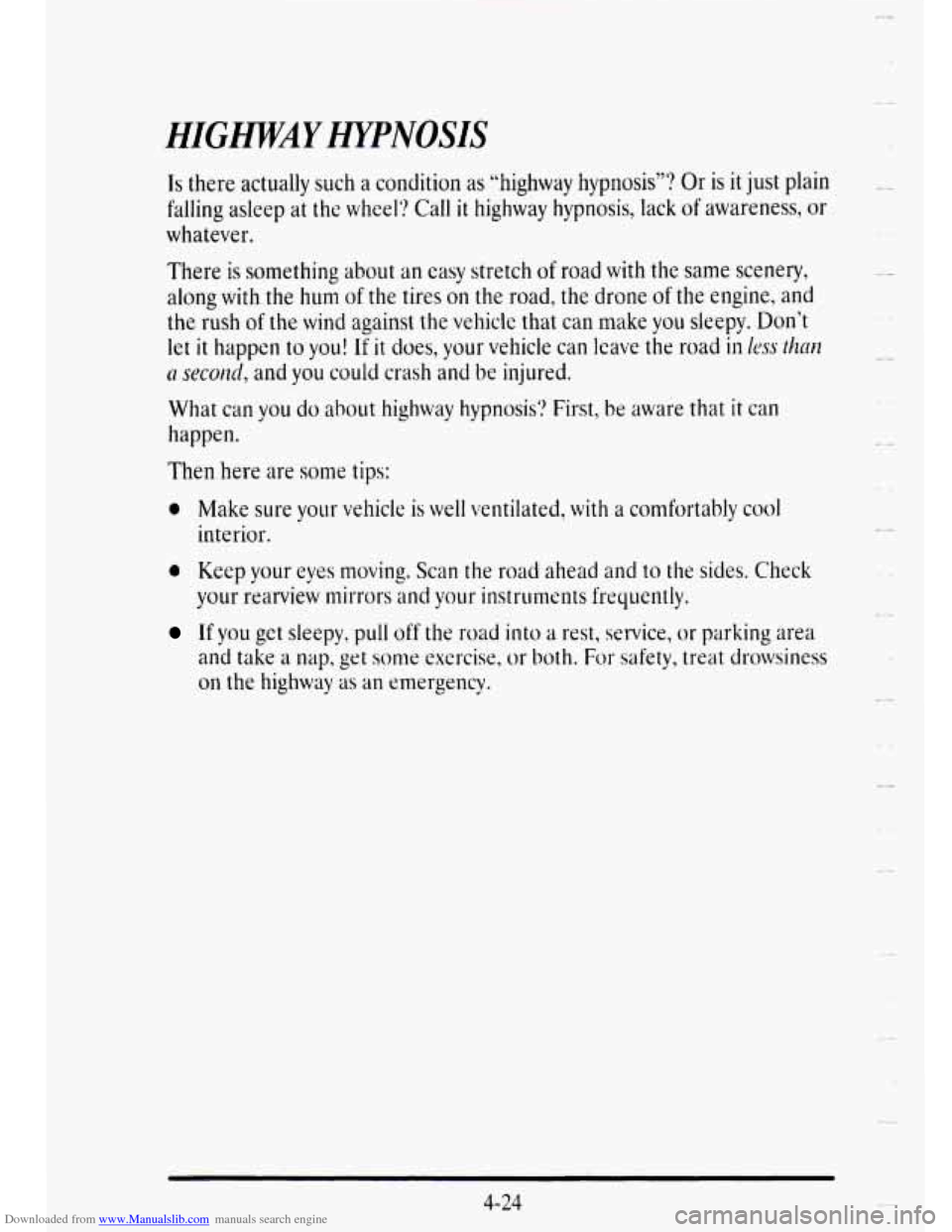
Downloaded from www.Manualslib.com manuals search engine HIGmAY HYPNOSIS
Is there actually such a condition as “highway hypnosis”? Or is it just plain
falling asleep at the wheel‘? Call
it highway hypnosis, lack of awareness, or
whatever.
There
is something about an easy stretch of road with the same scenery,
along
with the hum of the tires on the road, the drone of the engine, and
the
rush of the wind against the vehicle that can make you sleepy. Don’t
let it happen to you! If it does, your vehicle can leave the road in less tlm
n secmd, and you could crash and be injured.
What can
you do about highway hypnosis‘? First, be aware that it can
happen.
Then here are some tips:
0 Make sure your vehicle is well ventilated, with a comfortably cool
interior.
0 Keep your eyes moving. Scan the road ahead and to the sides. Check
your rearview mirrors and your instruments frequently.
If you get sleepy, pull off the road into a rest, service, or parking area
and take a nap, get some exercise, or both. For safety, treat drowsiness
on the highway as an emergency.
4-24